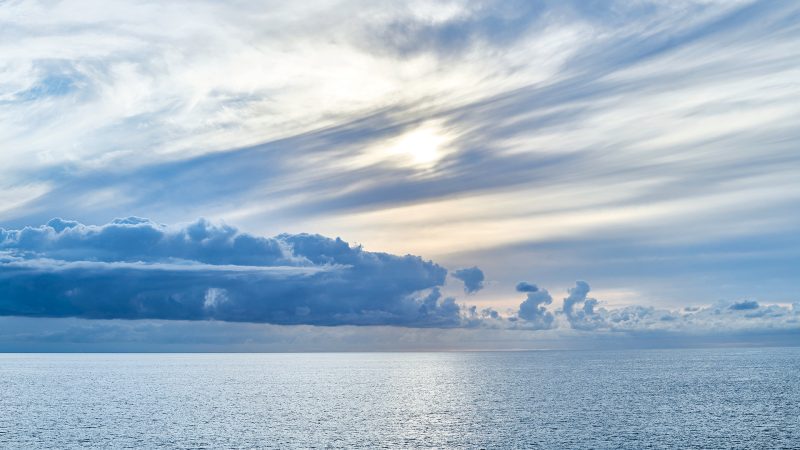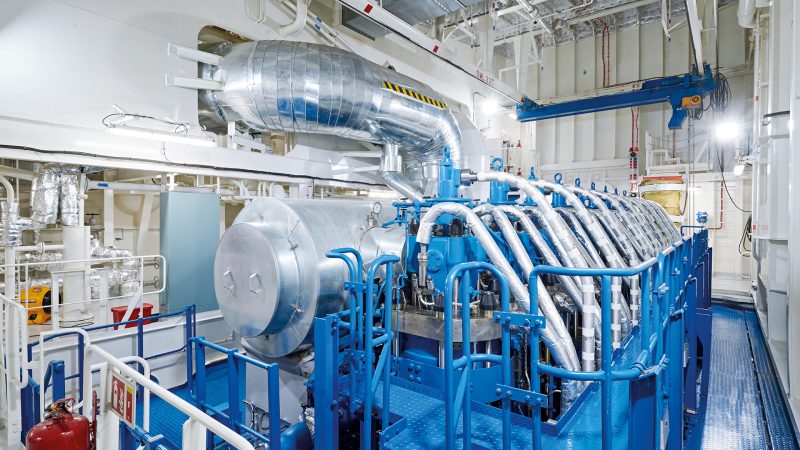Environment and safety
Environmental aspects have a pivotal role in Finnlines’ operations. We produce safe and first-class services in a manner that minimises environmental effects.

Shipping, which transports around 90 per cent of global trade, provides the principal mode of transport for the supply of raw materials, consumer goods, essential foodstuffs and energy to the global population. The vast majority of these products could not be transported any other way than by ship. The Covid-19 pandemic demonstrated the essential role played by transport and the social, health and economic costs when free movement of people, goods and services was severely constrained.
Air emissions
Shipowners have had to report on ships’ fuel consumption, subsequent CO2 emissions and transport work to the European Commission as from 2018 in accordance with an EU directive. Globally, a similar system, IMO’s Data Collection System, started in 2019. An accredited, impartial verifier validates the data in both systems.
Finnlines operates in ecologically sensitive sea areas, mainly in the Emission Control Areas, i.e. the Baltic Sea, the North Sea and the English Channel, where the sulphur content limit for fuel oil has been 0.10 per cent from 2015 in accordance with the MARPOL Convention, whereas globally, the sulphur limit decreased from 3.5 per cent to 0.5 per cent at the beginning of 2020. Finnlines has installed exhaust gas cleaning systems on 21 vessels since 2015 and will continue the project by installing equipment on the two remaining vessels.
The IMO has set the target to cut greenhouse gas emissions from shipping by 50 per cent by 2050. Fuel consumption per cargo tons carried and nautical miles sailed should decrease by 40 per cent by 2030 and by 70 per cent by 2050. All target figures are compared with the 2008 level. The European Commission has raised the stakes even higher by setting the goal for Europe to become a climate-neutral continent by 2050.
Finnlines has optimised its schedules and routes to achieve the highest possible capacity utilisation, which minimises the environmental stress per transported cargo unit. Ships run on optimal speed, load, and trim. The underwater hull is brushed regularly during the open-water season to remove micro organisms, which have attached to the ship’s hull, increasing fuel consumption.
All ships have a Ship Energy Efficiency Management Plan, the purpose of which is to identify energy-saving measures and to establish practices to improve energy efficiency.
Finnlines invests in sustainability in many ways on its new vessels. Main engines with low specific fuel consumption have been chosen. Installation of solar panels, a high-powered battery bank, an air lubrication system, and shore-side electricity are included in the Green Newbuilding Programme. Installation of a shore-side connection on several existing ro-pax vessels is also being prepared. Moreover, gradual transition to carbon-free and renewable fuels is being investigated.
Green transition
Both globally and within the European Union, numerous proposals are being discussed to combat the climate change. To reach the ambitious goals, the shipping sector will have to consider transition to alternative carbon-neutral fuels and adoption of new technologies.
The EU Commission has adopted a “Fit for 55” package where three proposals are maritime-related.
- The Commission has adopted to include maritime transport in the emissions trading system, which has covered energy-intensive industries and flights within EU for nearly two decades. The system only concerns CO2 emissions from ships of at least 5,000 GT and allowances may be bought and sold between industries. One of Finland’s major targets was adopted and ice classed vessels were granted a 5 per cent deduction from their CO2 emissions as they consume more fuel than other vessels due to the ice strengthened structure.
- The planned FuelEU Maritime Initiative will set a maximum limit on the greenhouse gas content of energy used by ships. Passenger ships and container ships will be required to use onshore power supply at berth unless they can demonstrate the use of an alternative zero-emission technology. Member states should ensure availability of onshore power by 1 January 2030.
- The Energy Taxation Directive aims to promote clean technologies and discourage the use of fossil fuels. The EU plans to introduce taxes on fuels over a 10-year transitional period.
The carbon levy, i.e. a tax, which the International Chamber of Shipping has put forward to the IMO in September 2021, is intended to expedite the creation of a market that makes zero-emission shipping viable.
To reach the ambitious goal of becoming carbon neutral, it may be necessary to modify existing ships with new tanks and engines so that they can run on new types of fuel. However, at current rates of production, zero-carbon fuels are not commercially available at the scale needed for the global fleet.
Safety and security
The land-based ship management organisation and all the ships are certified in accordance with the International Safety Management Code (ISM). All ships and port facilities also comply with the requirements of the ISPS Code (International Ship and Port Facility Security Code).
Technical progress, such as digitalisation, integration and automation, brings a risk of malicious attacks to ships’ control systems. Shipowners have therefore identified cyber security objectives relevant for the safe operation of the ship.
Regular drills prepare for the unexpected.
The ships are regularly inspected and audited by the maritime administration, classification societies and by in-house auditors. Regular drills are held both internally and with authorities, such as the border guard, police and local city rescue departments.
In ports, stevedoring companies have safety systems, including communication and contingency plans in case of an accident. Ports are equipped to respond to fires and oil and chemical spills.
Environmental certification
The environmental management system, which complies with the ISO 14001:2015 standard, was audited in the office and onboard ships during 2022 and a new certificate was issued. Certification covers management and manning of all ships sailing under the Finnlines flag as well as purchasing, newbuildings, and cargo and ship operations.
Stakeholders
In environmental and safety matters, Finnlines’ most important stakeholders are the flag and port state administration, owners, customers, personnel, port operators, classification society and contractors, as well as the inhabitants of harbour and fairway areas.
Finnlines is represented at the technical, safety and environmental committees under the Swedish and Finnish Shipowners’ Associations and co-operates with maritime colleges and research centres. The company is an associated organization in the EU flagship project COMPLETE (Completing management options in the Baltic Sea Region to reduce risk of invasive alien species introduction by shipping). Finnlines has also been involved in the realtime algal monitoring project, Alg@line, on its Finland–Germany route for over 20 years, providing a space on its vessels for research purposes.

Legislation
IMO manages international legislation on safety and environmental matters. The MARPOL 73/78 Convention contains regulations on the disposal of waste and sewage and on the prevention of air emissions. The SOLAS Convention regulates maritime safety and security, including ship construction, life-saving arrangements and navigation. Port operations comply with national and international legislation.
To ensure safe and environmentally sound recycling of ships, the Hong Kong Convention has been adopted within IMO, but the Convention has not yet been ratified. This is why EU has adopted a regulation on ship recycling and inventory of hazardous materials, like mercury, cadmium and lead. Hazardous materials experts have identified the presence of hazardous material contained in the equipment and systems onboard. An inventory shall be maintained throughout the operational life of the ship.
Ballast water management
Ballast water is used to trim and stabilise ships, but it may carry harmful aquatic species and out-compete native species, disrupting fragile marine ecosystems. In accordance with the IMO Ballast Water Management Convention, ships must be fitted with treatment equipment during a transitional period. Finnlines has completed equipment installations.
Other environmental aspects
Oily wastewater, ‘bilge water’, is generated in engine rooms. Bilge water is separated in separators and the remaining sludge is always taken ashore. The limit for the oil content of water that may be discharged into the sea is 15 ppm but many of our ships have more efficient separators. Some bilge water is also pumped ashore.
MARPOL contains restrictions concerning black water, i.e. toilet water. Finnlines’ ro-pax vessels land black and grey water to onshore municipal sewage systems. Cargo ships are equipped with sewage treatment plants, which have been certified by the administration. The target is to gradually reduce and stop discharging also treated waste water into the Baltic Sea. When technically feasible, some of the cargo ships are already delivering their treated waste waters into shore facilities.
Finnlines co-operates with waste management companies to reuse, recycle or recover waste in an efficient manner and waste is reprocessed into material or recovered as energy. The main waste types generated on board include plastics, bio waste, glass, paper, cardboard, wood, and metal. Hazardous waste is separated and taken to a designated container in the port.
Environmental aspects in port operations
Port and stevedoring operations are an important part of overall efficiency and performance of the Group. Finnsteve companies continue to invest in modern equipment and vehicles, which will take the environmental programme to the next level. NOx emissions from new tug masters, which will replace the old Tier 1 equipment, will reduce by 96 per cent and particles by 97 per cent. New electric vans and minibuses will be emission free.
Finnsteve companies hold a valid ISO 14 001 environmental certificate and an ISO 9001 quality certificate.
In 2022, the fuel consumption of the port operations totalled 1,165,119 litres, which includes the operations in Helsinki, Turku and Naantali, a decrease of 3 per cent compared with the previous year.